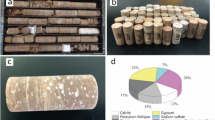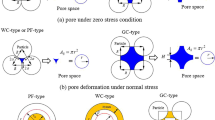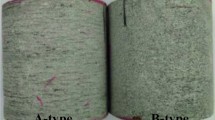Abstract
The creep deformation behaviour of soft rocks is one of the most important research fields in geotechnical engineering. In this study, a theoretical model was developed to investigate the coupled effects of the grain dissolution–diffusion sliding and the hydro-mechanical interaction on the creep behaviour of soft rocks. Experimental results validated the model. The results demonstrate that the creep of soft rocks is primarily dependent on the shear stress on the sliding surface, the average thickness of the hydrated film and the amplitude of the cosinusoidal sliding surface. These three parameters can be used to describe the meso-mechanism of soft rock creep stages, i.e. the transient creep stage, steady-state creep stage, and accelerated creep stage. In addition, this study’s findings show that the chemical potential field promotes the mineral dissolution and diffusion on the grain sliding surface and changes its morphology, thereby resulting in the redistribution of stress.













Similar content being viewed by others
References
Boioli F, Carrez P, Cordier P, Devincre B, Marquille M (2015) Modeling the creep properties of olivine by 2.5-dimensional dislocation dynamics simulations. Phys Rev B 92(1):014115
Chong M, Bin H, Hongbing Z, Xingang W (2016) Triaxial rheological mechanism and creep model of mudstone under complex stress. Electron J Geotech Eng 21(6):2127–2142
Deng HF, Zhou ML, Li JL, Sun XS, Huang YL (2016) Creep degradation mechanism by water–rock interaction in the red-layer soft rock. Arab J Geosci 9(12):601
Eriksson R, Schatz T (2015) Rheological properties of clay material at the solid/solution interface formed under quasi-free swelling conditions. Appl Clay Sci 108:12–18
Fan QY, Yang KQ, Wang WM (2010) Study of creep mechanism of argillaceous soft rocks. Chin J Rock Mech Eng 29(8):1555–1561
Firme PALP, Roehl D, Romanel C (2016) An assessment of the creep behaviour of Brazilian salt rocks using the multi-mechanism deformation model. Acta Geotech 11(6):1–19
Firme P, Brandao N, Roehl D, Romanel C (2018) Enhanced double-mechanism creep laws for salt rocks. Acta Geotech 13(6):1329–1340
Gee ML, McGuiggan PM, Israelachvili JN, Homola AM (1990) Liquid to solid like transitions of molecularly thin films under shear. J Chem Phys 93(3):1895–1906
Getsinger AJ, Hirth G (2014) Amphibole fabric formation during diffusion creep and the theology of shear zones. Geology 42(6):535–538
Hirth G, Kohlstedt DL (2015) The stress dependence of olivine creep rate: implications for extrapolation of lab data and interpretation of recrystallized grain size. Earth Planet Sci Lett 418:20–26
Jaeger JC, Cook NGW, Zimmerman RW (2007) Fundamentals of rock mechanics, 4th edn. Blackwell Publishing, Oxford, pp 268–269
Kilian R, Heilbronner R, Stünitz H (2011) Quartz grain size reduction in a granitoid rock and the transition from dislocation to diffusion creep. J Struct Geol 33(8):1265–1284
Liu X (1986) Discussion of general creep equation and its experimental verification. Chin J Rock Mech Eng 5(3):245–256
Liu Z, Zhou CY, Li BT, Lu YQ, Yang X (2018) A dissolution–diffusion sliding model for soft rock grains with hydro-mechanical effect. J Rock Mech Geotech Eng 3:457–467
Luo XJ, Yang WD, Li RX, Gao LP (2001) Effects of pH on the solubility of the feldspar and the development of secondary porosity. Bull Mineral Petrol Geochem 20(2):103–107
Ma G, Zhou W, Ng TT, Cheng YG, Chang XL (2015) Microscopic modeling of the creep behavior of rockfills with a delayed particle breakage model. Acta Geotech 10(4):481–496
Mclaren AC (1978) Crystalline plasticity and solid state flow in metamorphic rocks. Earth Sci Rev 14(2):171–172
Miyazaki T, Sueyoshi K, Hiraga T (2013) Olivine crystals align during diffusion creep of Earth’s upper mantle. Nature 502(7471):321–326
Okubo S, Fukui K, Hashiba K (2008) Development of a transparent triaxial cell and observation of rock deformation in compression and creep tests. Int J Rock Mech Min Sci 45(3):351–361
Pashley RM (1982) Hydration forces between mica surfacesin electrolyte solutions. Adv Colloid Interface Sci 16(1):57–62
Qin DH, Qin Y, Mao T (2014) Crack initiation extension fracture of rock deformation and destruction. Electron J Geotech Eng 19(Z4):16971–16979
Raj R, Ashby MF (1971) On grain boundary sliding and diffusional creep. Metall Trans 2(4):1113–1127
Ren JX, Ge XR, Yang GS (2001) CT real-time testing on damage propagation microscopic mechanism of rock under uniaxial compression. Rock Soil Mech 22(2):130–133
Renard F, Ortoleva P, Gratier JP (1997) Pressure solution in sandstones: influence of clays and dependence on temperature and stress. Tectonophys 280(3–4):257–266
Rutter EH, Mainprice DH (1978) The effect of water on stress relaxation of faulted and unfaulted sandstone. Pure Appl Geophys 116:634–654
Shen LF, Feng XT, Pan PZ, Zhou H (2011) Chemical kinetics dissolution mechanism of rock under stress. Rock Soil Mech 32(5):1320–1326
Takemura T, Oda M, Kirai H, Golshani A (2012) Microstructural based time-dependent failure mechanism and its relation to geological background. Int J Rock Mech Min Sci 53:76–85
Tang H, Wang D, Huang R, Pei X, Chen W (2017) A new rock creep model based on variable-order fractional derivatives and continuum damage mechanics. Bull Eng Geol Env 2017:1–9
Urai JL, Spiers CJ, Hendrik JZ, Lister GS (1986) Weakening of rock salt by water during long-term creep. Nature 324:554–557
Wang Z, Wong RCK (2015) Strain-dependent and stress-dependent creep model for a till subject to triaxial compression. Int J Geomech 16(3):04015084
Xu T, Xu Q, Tang CA, Ranjith PG (2013) The evolution of rock failure with discontinuities due to shear creep. Acta Geotech 8(6):567–581
Yang CH, Li JG (2006) Analysis of creeping mechanisms of non-uniformity soft rocks. J Min Saf Eng 23(4):476–479
Zhang Y, Shao JF, Xu WY, Jia Y, Zhao HB (2015) Creep behaviour and permeability evolution of cataclastic sandstone in triaxial rheological tests. Eur J Environ Civ Eng 19(4):496–519
Zhou M, Song E (2016) A random virtual crack DEM model for creep behavior of rockfill based on the subcritical crack propagation theory. Acta Geotech 11(4):827–847
Acknowledgements
The research is supported by the National Natural Science Foundation of China (NSFC) (Grant Nos. 41472257, 41530638, 41372302), the National Key Research and Development Project (Grant Nos. 2017YFC1501201, 2017YFC0804605), the Special Fund Key Project of Applied Science and Technology Research and Development in Guangdong (Grant Nos. 2015B090925016, 2016B010124007), and the Special Support Programme for High Level Talents in Guangdong (Grant No. 2015TQ01Z344).
Author information
Authors and Affiliations
Corresponding author
Additional information
Publisher's Note
Springer Nature remains neutral with regard to jurisdictional claims in published maps and institutional affiliations.
Rights and permissions
About this article
Cite this article
Liu, Z., Zhou, C., Li, B. et al. Effects of grain dissolution–diffusion sliding and hydro-mechanical interaction on the creep deformation of soft rocks. Acta Geotech. 15, 1219–1229 (2020). https://doi.org/10.1007/s11440-019-00823-9
Received:
Accepted:
Published:
Issue Date:
DOI: https://doi.org/10.1007/s11440-019-00823-9




